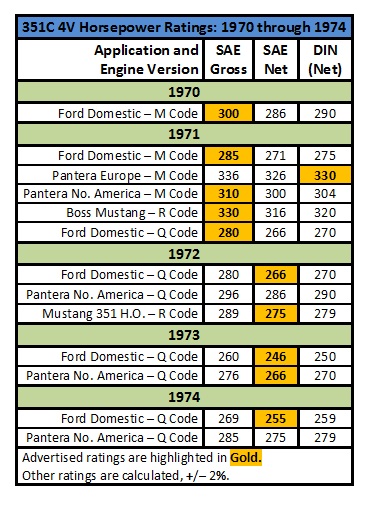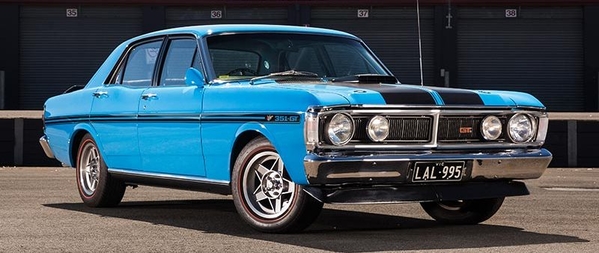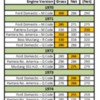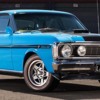Happy Thanksgiving.
The short answer is, the output of a 1974 Pantera L was 279 DIN horsepower, 275 SAE Net horsepower, or 285 SAE Gross horsepower.
Horsepower ratings are obfuscated. That's today's word.  There are several reasons.
There are several reasons.
First: The Society of Automotive Engineers (SAE) defines one horsepower as the ability to lift 33,000 pounds one foot in one minute. The DIN/ISO/JIS however, define one horsepower as the ability to lift 45,000 kg one centimeter in one minute, about 98.6% of an SAE horsepower. An SAE horsepower accomplishes a little more work than the others. An engine rated 300 SAE horsepower is equivalent to an engine rated 304 DIN horsepower merely by the definitions of horsepower involved.
Second: There are varying measurement standards, those relevant to your question are SAE Gross (SAE J245 and J1996), SAE Net (SAE J1349) and DIN Horsepower (DIN 70020). The DIN standard is also a "Net horsepower" standard, similar to the SAE Net standard; DIN horsepower numbers tend to run higher than SAE Net numbers for the same engine. The USA mandated the use of SAE Net horsepower beginning the 1972 model year. Prior to 1972 the US manufacturers quoted SAE Gross horsepower with varying amounts of "cheating".
Its vital to compare apples to apples, so you must distinguish between SAE or DIN horsepower, and if its SAE horsepower you must distinguish between Gross horsepower and Net horsepower. Books and magazines often failed to state exactly what type of horsepower they were quoting … and when they did they were wrong a few times.
Finally the early 1970s were a period of constant change in regard to engine performance. Horsepower figures were changing year to year. There was not one fixed horsepower spec for Panteras … or any other vehicle equipped with an American made engine. Although De Tomaso quoted one fixed value for European Panteras from 1971 to 1974 … that was not the situation.

Here are the details you can discuss with your friend:
The earliest Panteras were equipped with US Ford "M code" engines. The M code engine of 1971 went into production in July 1970, it was rated 285 SAE Gross horsepower (271 SAE Net, or 275 DIN). These were equipped with cast iron exhaust manifolds and Autolite 4300A carburetors. The 4300A carburetors were rated by Ford at 630 CFM, but measured like a Holley would be rated approximately 450 CFM. They were small carburetors. The carburetor of the 1971 version was tuned leaner for emissions and the engine's compression was lowered from 10:1 in 1970 to 9.5:1 for 1971 to suit the leaner carburetor.
The De Tomaso factory at Via Jacopo Peri was equipped with dynamometers. The 330 horsepower quoted by De Tomaso was actually measured. I assume this is DIN horsepower, they were in Italy after all. Getting from 275 DIN (285 SAE Gross) to 330 DIN takes an addition of 55 horsepower. So the question is, where did the additional 55 horsepower come from? These early Pantera engines were equipped with De Tomaso exhaust manifolds and 600 CFM Holley carburetors. It is easy for me to believe the differences in carburetor size and tuning accounted for 30 horsepower, more difficult for me to believe the De Tomaso exhaust may have accounted for a 25 horsepower increase. However, all this considered, 330 DIN horsepower was possible ... in Europe … in 1971. It was probably the output of a "best example" rather than the output of an "average example". Unfortunately De Tomaso continued to advertise that figure year after year for European Panteras, which does not reflect the year by year changes in the engine's state of tune. The European DIN horsepower for 1972, 1973, and 1974 would have most likely been 290, 270, and 279 with Motorcraft carburetors or 310, 290, and 299 with Holley carburetors.
The output of the Pantera's engine was NEVER rated 330 horsepower in the US, that was the European rating. Replacing Autolite carburetors with Holley carburetors ceased once Ford stepped-in and took over assembling Panteras for the US market. The horsepower rating in the US was advertised as 310 horsepower, I assume that was SAE gross horsepower. I believe this rating was based on genuine dyno measurements. Remember, the same engine in a Mustang or Torino was rated 285 SAE Gross horsepower. The only difference to account for the 25 additional horsepower was that the Pantera engine had the De Tomaso exhaust.
266 horsepower was the output rating of a 1972 Q code engine, which was rated using the SAE NET measurement criteria. The same engine had been rated 280 SAE Gross horsepower a few months earlier, near the end of the 1971 model year. To arrive at a "NET" horsepower reading the 1972 versions were measured with "typical accessories" installed and operating. This meant they were equipped with power steering pumps, water pumps, alternators and fuel pumps. It seems these accessories consumed only 14 horsepower.
I assume the output of the 1972 Pantera's engine was 286 SAE Net horsepower based on Ford's 1973 example (explained below).
Compared to the previous M code engines the Q code versions had significantly leaner carburetors and correspondingly lower compression (8.6:1), but higher lift cams. The heads employed open combustion chambers to lower the compression, which provided the benefit of improved air flow at low valve lift. The carburetors were Motorcraft 4300D versions, rated 750 CFM by Ford, probably about 600 CFM if rated using Holley criteria. The 1973-1974 versions had an even leaner tuned carburetors than the 1972 version, and correspondingly lower compression ratios as well (8.0:1). They were also equipped with exhaust gas recirculation. Ford's horsepower rating for the 1973 version plummeted to 246 SAE Net horsepower. However, in the Panteras favor - they didn't have power robbing power steering and they had the De Tomaso exhaust manifolds. Thus Ford advertised the horsepower rating of the 1973 Pantera as 266 SAE Net horsepower. This was the Pantera's lowest advertised rating. You won't find that rating in any Ford literature I'm aware of, but its the number reported in several US magazines during 1973 ... I assume the number was provided to the magazines by Ford.
The output of the Q code engine in your 1974 Pantera was up from the previous year, it was rated by US Ford at 255 SAE Net horsepower. Following Ford's 1973 example, this should be adjusted upward by 20 horsepower for the Pantera. Thus as it sat in your US Pantera's engine bay its output was likely 275 SAE Net horsepower, equivalent to 279 DIN horsepower, or 285 SAE Gross horsepower. If I'm keeping everything straight in my mind ... a tough thing to do. 
L model Panteras (I've never paid attention to the year) with stock engines normally pull 220 horsepower on a chassis dyno, which is equivalent to about 275 SAE Net horsepower.
I've also seen a Boss 351, equipped with headers and a 780 cfm Holley carburetor, pull 295 horsepower on a chassis dyno, which is equivalent to about 370 SAE Net horsepower. The 1971 XY Falcons (Australian), in Phase III GTHO tune, made similar horsepower (under-rated by Ford Australia at 300 horsepower) with similar engines. The engines were based on US manufactured M code engines with Holley carburetors, solid tappet cams, and tube exhaust added by Ford Australia. They were the fastest sedans in the world at the time.
Take a 1970-1972 short block (flat top pistons), add 1970 4V heads (10:1 compression), add a performance tuned 650 cfm Holley style carburetor to the 1970/1971 cast iron intake manifold, employ the high lift Q code camshaft and the De Tomaso GTS exhaust system. An engine assembled in that configuration will deliver 360 SAE Net horsepower at 5800 rpm, burning 95 octane fuel (91 octane in the US/Canada). The performance of an engine thus configured is very impressive from every aspect ... drivability, low rpm pep, acceleration, power band, and top end power.







